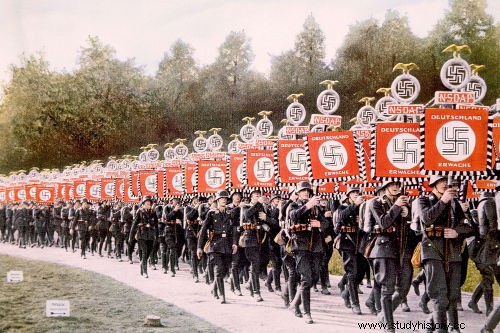
By Me. Cláudio Fernandes
At the beginning of World War II , the Nazis organized special operations groups under the SS (paramilitary elite troop of the III Reich ) and which were titled Einsatzgruppen . These organizations consisted, roughly, of death squads trained to seek out and kill those who were deemed “undesired” by the Hitler regime. The Einsatzgruppen they received from the armed forces of the Third Reich all the support they needed to fulfill their missions. They had a strong presence in 1941, when there was the German attack on the Soviet Union. To understand the content of such missions, it is necessary to know a little about the context in which they took place.
We know that shortly before Germany invaded Poland in September 1939 and triggered World War II, the Nazis signed a secret agreement with the Soviets, known as Pact Ribbentrop-Molotov. This pact had as main objective to guarantee the non-involvement of the USSR in the European resistance against the onslaughts of Germany. In exchange, the Soviets would take part of the spoils of war of the invaded countries – like Poland itself. However, we also know that this pact was broken in June 1941, when the Operation Barbarossa, that is, a German military mega-operation against the Soviet Union. It was in this phase of invasion of Soviet territory that the actions of the Einsatzgruppen. began.
The Einsatzgruppen were led by officer Reinhard Tristan Eugen Heydrich e they had the official function of “ensuring the security of the occupied territories”. In addition to this bureaucratic function, other missions were given to these groups, as well highlighted by historian Philippe Burrin:
The only documents that allow us to appreciate the task of the Einsatzgruppen are signed by Heydrich and date from the start of the campaign. The first is a July 2 letter addressed to the HSSPF Himmler had just appointed. Not having had the opportunity to meet them in Berlin before his departure, Heydrich communicated to them the essential directives he had given the Einsatzgruppen. Its mission was to ensure the security of the occupied territories. In addition to usual tasks (confiscation of files, creation of a surveillance and information network, etc.), he was supposed to perform certain categories of people. The main ones were communist party officials, radical elements and “Jews who held positions in the party and in the state” (“Juden in Partei – und Staatsstelugen”). [1]
Among the “special missions” against Soviet Jews were:the promotion of pogroms (destruction of Jewish dwellings, synagogues and shops), as well as the elimination by shooting of these Jews. Later, however, the targets became not just Jews linked to the Soviet Communist Party, but any Jews found in the occupied regions. As if this type of “target” were not enough, the Einsatzgruppen they proceeded with the shooting of mentally ill and physically disabled people in USSR sanatoriums. All the dead were buried in large mass graves.
The action of the Einsatzgruppen was considered by many historians as an anticipation of the mass deportations and concentration and extermination camps that were developed by the Nazis in the following years.
